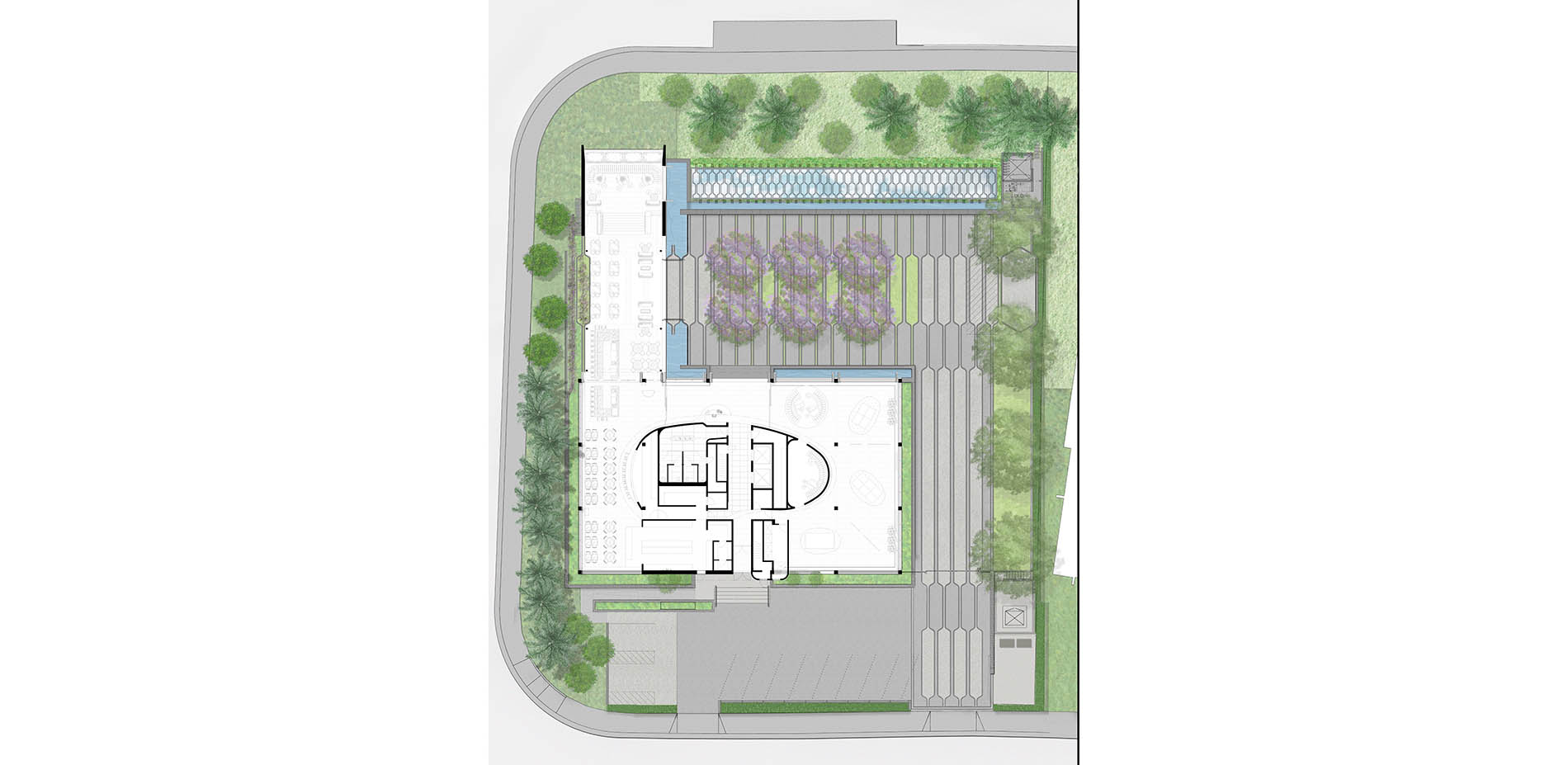
Site Plan
Photo Credit: Marion Brenner
Media: Please submit high-resolution image requests to images@asla.org.
Keying off of Ossipoff’s façade, a new courtyard at IBM Victoria Ward showcases a landscape expression of modern Hawaiian architectural motifs. The water feature forms the edge of the courtyard, reflecting the play and ephemerality of light throughout the day.
Photo Credit: Marion Brenner
Media: Please submit high-resolution image requests to images@asla.org.
At dusk, the magic moment, the polarized glazing of Ossipoll’s building reflects multiple color spectrums across the surface of the water.
Photo Credit: Marion Brenner
Media: Please submit high-resolution image requests to images@asla.org.
The plaza expresses an abstraction of the building pattern, creating long (lawn) boards in the paving pattern. These native grass plantings create a blurred edge to the crisp architecture and conjure images of surfboards riding the horizon of the nearby beach.
Photo Credit: Marion Brenner
Media: Please submit high-resolution image requests to images@asla.org.
Materials, light and sound converge to create a dynamic edge that encapsulates the architecture of Ossipoll and the mythical heritage of Hawaii.
Photo Credit: Marion Brenner
Media: Please submit high-resolution image requests to images@asla.org.
Inscribed runnels of stainless steel and glass frame ever-changing reflections, as water trickles down into a lush taro garden. Taro—essential to the agricultural, and cultural history of Hawaii—is an expression of vitality and sense of place.
Photo Credit: Marion Brenner
Media: Please submit high-resolution image requests to images@asla.org.
Providing new ways of engaging with the architecture, the water feature showcases moving reflections of light that capture the façade and project it as a new dynamic horizon for the site that bridges landscape and architecture.
Photo Credit: Marion Brenner
Media: Please submit high-resolution image requests to images@asla.org.
The courtyard tells the story of the literal ground it sits on—releasing the dynamic quality of volcanic stone through a singular paving materials. Three surface treatments—honed, flamed and split-faced—are expressed through the abstracted language of the courtyard.
Photo Credit: Marion Brenner
Media: Please submit high-resolution image requests to images@asla.org.
The pattern integrates further as water spills into a moat that wraps the space, creating an illusion that the courtyard floats in the sky. The moat is fed by the cascade of scuppers dancing along the elevated fountain edge.
Photo Credit: Marion Brenner
Media: Please submit high-resolution image requests to images@asla.org.
Three contrasting textures are revealed as the Hawaiian sun interacts with the courtyard paving. The honed catch light and bring the sky to the ground; the split-faced, with their rugged quality give depth; and flamed appear to shimmer.
Photo Credit: Marion Brenner
Media: Please submit high-resolution image requests to images@asla.org.
Hawaiian mythology is dynamically expressed through the patterns of water and light as the sky father is projected through the glass bottom of the water feature onto the taro plantings and earth mother below.
Photo Credit: Zhao Jie (AECOM), Scott Burrows (Consultant), Marion Brenner
Media: Please submit high-resolution image requests to images@asla.org.
Located on busy Ala Moana Boulevard, the water feature forms a new horizon line connecting the courtyard to the beach, as the tricking water sounds mask traffic. New palm and fragrant plumeria plantings connect to the plantings of Alamoana beach park.
Photo Credit: Marion Brenner
Media: Please submit high-resolution image requests to images@asla.org.
Native grass turf forms scaled ‘lawn boards’ interwoven in the courtyard hardscape and function as permeable soakage features that allow water to percolate into the water table.
Photo Credit: Marion Brenner
Media: Please submit high-resolution image requests to images@asla.org.
Across the length of the elevated water feature, palms appears.
Photo Credit: Marion Brenner
Media: Please submit high-resolution image requests to images@asla.org.
At the sunset hour, the courtyard is awash with a pink glow of the parting sun.
Photo Credit: Marion Brenner
Media: Please submit high-resolution image requests to images@asla.org.


















